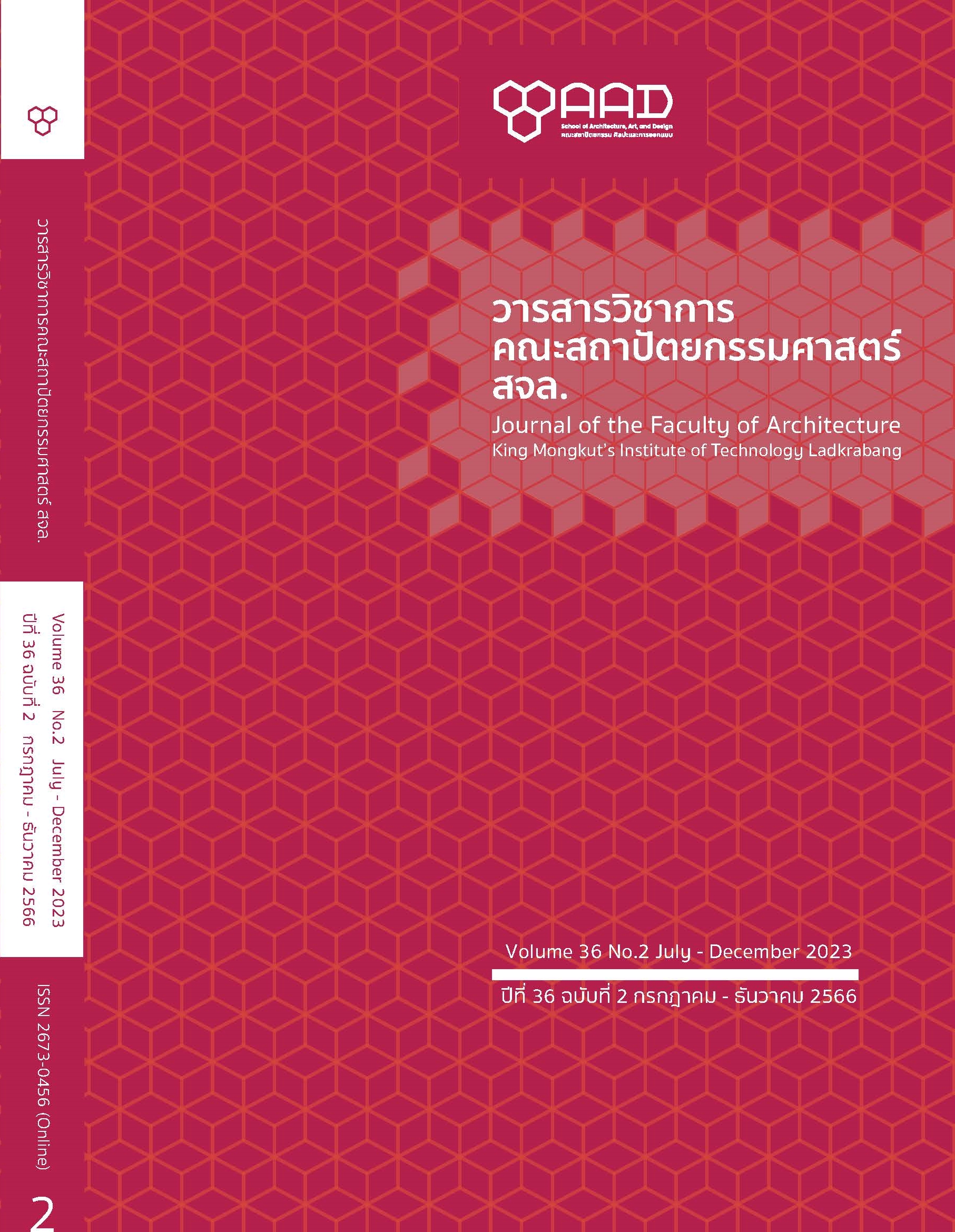การประเมินความต้องการจำเป็นในการพัฒนาคุณลักษณะบัณฑิตที่พึงประสงค์ของนักศึกษาระดับปริญญาตรีชั้นปีที่ 1 หลักสูตรศิลปกรรมศาสตรบัณฑิต สาขาวิชาการออกแบบสนเทศสามมิติและสื่อบูรณาการ คณะสถาปัตยกรรม ศิลปะและการออกแบบ สถาบันเทคโนโลยีพระจอมเกล้าเจ้าคุณทหารลาดกระบัง
Main Article Content
บทคัดย่อ
วัตถุประสงค์เพื่อ 1) ประเมินความต้องการจำเป็นในการพัฒนาคุณลักษณะอันพึงประสงค์ตามมาตรฐานคุณวุฒิระดับอุดมศึกษา และคุณลักษณะเฉพาะด้านตามผลลัพธ์การเรียนรู้อันพึงประสงค์ของนักศึกษาระดับปริญญาตรีชั้นปีที่ 1 ในสภาพความเป็นจริงและสภาพที่คาดหวัง 2) ศึกษาค่าดัชนีลำดับความสำคัญของความต้องการจำเป็นในการพัฒนาคุณลักษณะอันพึงประสงค์ในนักศึกษาชั้นปีที่ 1 ของหลักสูตรฯ 3) ศึกษาระดับความสำคัญของคุณลักษณะอันพึงประสงค์ของนักศึกษาชั้นปีที่ 1 ของหลักสูตรฯ 4) ศึกษาความคิดเห็นของคณาจารย์ประจำหลักสูตรและผู้เชี่ยวชาญต่อการพัฒนาคุณลักษณะที่พึงประสงค์ กลุ่มประชากรคือ นักศึกษาชั้นปีที่ 2 ภาคการศึกษาที่ 1/2565 หลักสูตรศิลปศาสตรบัณฑิต สาขาการออกแบบสนเทศสามมิติและสื่อบูรณาการ คณะสถาปัตยกรรม ศิลปะและการออกแบบ สถาบันเทคโนโลยีพระจอมเกล้าเจ้าคุณทหารลาดกระบัง จำนวน 33 คน อาจารย์ประจำหลักสูตรจำนวน 6 คน และผู้เชี่ยวชาญจำนวน 3 คน เครื่องมือในการวิจัย 1)แบบสอบถามความต้องการจำเป็นในการพัฒนาคุณลักษณะอันพึงประสงค์ 2) แบบสอบถามอาจารย์ประจำหลักสูตรและผู้เชี่ยวชาญ การวิเคราะห์ข้อมูลโดยใช้สถิติบรรยาย สถิติที่ใช้ได้แก่ ค่าเฉลี่ย ส่วนเบี่ยงเบนมาตรฐาน ค่าดัชนีลำดับความสำคัญ
ผลการวิจัย 1) ผลการประเมินความต้องการจำเป็นตามมาตรฐานคุณวุฒิระดับอุดมศึกษาในสภาพความเป็นจริงอยู่ในระดับมาก (x̅ = 3.87, S.D.= 0.93) และในสภาพที่คาดหวังอยู่ในระดับมากที่สุด (x̅ = 4.71, S.D. = 0.55) ผลการประเมินความต้องการจำเป็นคุณลักษณะเฉพาะด้านในสภาพความเป็นจริงอยู่ในระดับมาก (x̅ = 3.76, S.D. = 0.91) และในสภาพที่คาดหวังอยู่ในระดับมาก (x̅ = 4.36, S.D. = 0.66) 2) ค่าดัชนีลำดับความสำคัญของความต้องการจำเป็นตามมาตรฐานคุณวุฒิมีค่าเท่ากับ 0.22 และค่าดัชนีลำดับความสำคัญของความต้องการจำเป็นคุณลักษณะเฉพาะด้าน มีค่าเท่ากับ 0.24 3) ระดับความสำคัญของคุณลักษณะอันพึงประสงค์ตามมาตรฐานคุณวุฒิระดับอุดมศึกษาอยู่ในระดับมากที่สุด (x̅ = 4.60, S.D. = 0.84) และระดับความสำคัญของคุณลักษณะเฉพาะด้านที่พึงประสงค์อยู่ในระดับมาก (x̅ = 4.31, S.D. = 0.87) ผลความคิดเห็นจากแบบสอบถามอาจารย์ประจำหลักสูตรและผู้เชี่ยวชาญพบว่า ควรพัฒนาผู้เรียนด้านความรู้ ด้านทักษะ ด้านจริยธรรม และด้านลักษณะบุคคลควบคู่กัน โดยบูรณาการรายวิชาในหลักสูตรหลายรายวิชาเข้าด้วยกัน ฝึกทักษะการคิดวิเคราะห์และทักษะพื้นฐานผู้เรียนให้รอบด้าน และมุ่งเน้นให้ผู้เรียนมีจริยธรรมและทักษะด้านลักษณะบุคคลเป็นพื้นฐาน
Article Details

อนุญาตภายใต้เงื่อนไข Creative Commons Attribution-NonCommercial-NoDerivatives 4.0 International License.
This work is licensed under a Creative Commons Attribution-NonCommercial-ShareAlike 4.0 International License.
Copyright Transfer Statement
The copyright of this article is transferred to Journal of The Faculty of Architecture King Mongkut's Institute of Technology Ladkrabang with effect if and when the article is accepted for publication. The copyright transfer covers the exclusive right to reproduce and distribute the article, including reprints, translations, photographic reproductions, electronic form (offline, online) or any other reproductions of similar nature.
The author warrants that this contribution is original and that he/she has full power to make this grant. The author signs for and accepts responsibility for releasing this material on behalf of any and all co-authors.
เอกสารอ้างอิง
Ekwutwongsa, S. (2016). A development design learning book on analytical thinking for product design. The Fine and Applied Arts Journal, 11(1), 105-126. https://so05.tci-thaijo.org/index.php/fineartstujournal/article/view/233831/160716 (in Thai)
Khlaichom, S., Lo̜meng, A., Pho̜wongpinyo, N., Thanchaichon, S., & Paenklam, K. (2022). The developing potential for teaching management in architecture design by project -based learning. Buabandit Journal of Education Administration, 22(2), 15-24. https://so06.tci-thaijo.org/index.php/BUAJEAD/article/view/250603/176032 (in Thai)
Maun, B. (2016). Effective management of teaching and learning at the higher education level. Journal of Southern Technology, 9(2), 169-176. https://so04.tci-thaijo.org/index.php/journal_sct/article/view/82156 (in Thai)
Ministry of Education, Office of the Basic Education Commission. (2015). 21st Century skills. Ebook. https://secondary.obec.go.th/newweb/wp-content/uploads/2017/12/E-CEN21book.pdf (in Thai)
Ministry of Higher Education, Science, Research and Innovation. (2022, March 31). Ministerial regulations
on higher education qualification standards. https://www.mhesi.go.th/images/2565/T_1390028.PDF (in Thai)
Orathai, P., & Tengtrakoon, S. (2011). An educational needs assessment for a Bachelor of Nursing Science program as perceived by Ramathibodi nursing graduates. Rama Nurse Journal, 17(3), 463-477. https://he02.tci- thaijo.org/index.php/RNJ/article/view/9051/7710 (in Thai)
Toemyuan, T. (2005). A development of an effective instructional model for bachelor’ s degree program in higher education institute under the Jurisdiction of Fine arts department [Doctoral dissertation, Srinakharinwirot University]. http://thesis.swu.ac.th/swudis/Hi_Ed/Tawat_T.pdf (in Thai)
Wongwanit, S. (2015). Needs assessment research. Chulalongkorn University Press. (in Thai)


